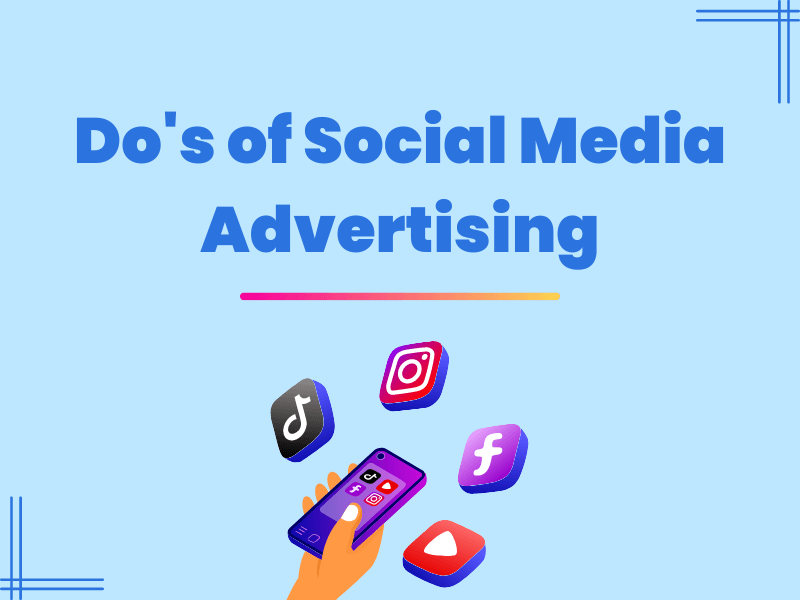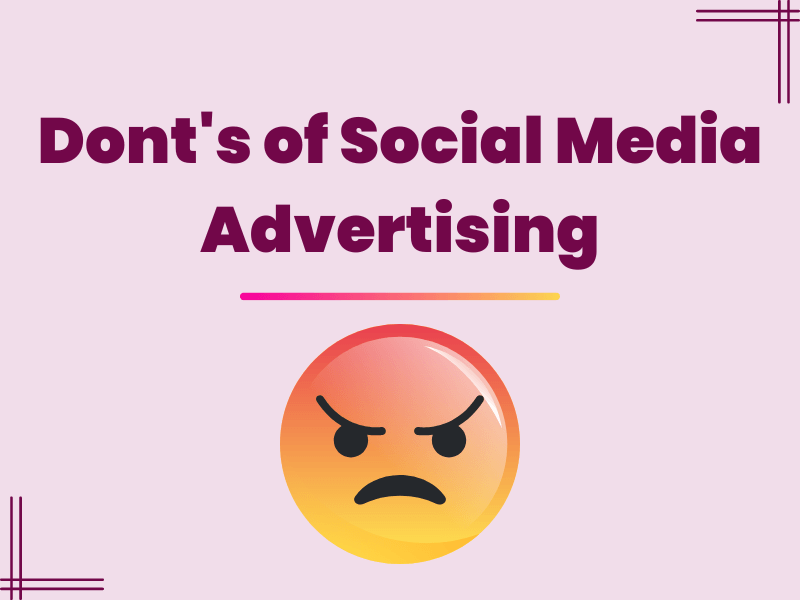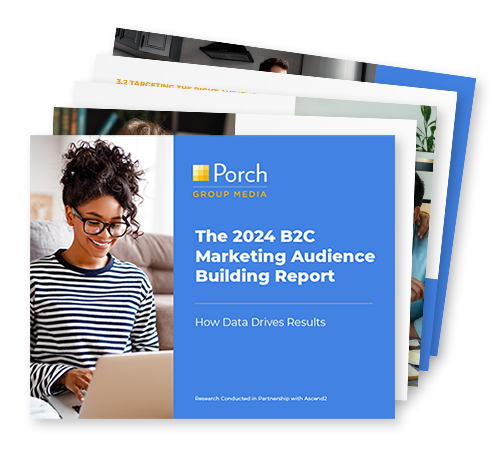Social media advertising is a powerful tool for reaching your target audience and driving conversions. However, it’s essential to understand the dos and don’ts of social media advertising to deploy successful campaigns. Read on to learn about the dos and don’ts of social media advertising to create effective campaigns that reach your audience, drive engagement, and achieve your advertising goals.

7 Do’s of Social Media Advertising
1. Do Identify Your Target Audience
91% of social media users say they’re more likely to engage with brands that offer personalized recommendations and content that’s relevant to them. Sprout Social
Identifying your target audience is essential for creating effective social media advertising campaigns. Knowing your audience allows you to tailor your messaging and visuals to their interests, preferences, and needs, which can increase the likelihood of engagement and conversions.
By understanding who your audience is, you can also determine which social media platforms they use most frequently and target your advertising efforts accordingly. Additionally, targeting a specific audience can help you optimize your ad spend and avoid wasting resources on viewers who are unlikely to be interested in your product or service.
2. Do Build Your Presence on the Right Platforms
72% of adults who use Instagram are under the age of 35, while 81% of adults aged 18 to 29 use Snapchat. In comparison, Facebook is more evenly distributed among different age groups, with 69% of adults aged 50 to 64 and 46% of those aged 65 and older using the platform. Pew Research Center
Building your social media presence on the right platforms is crucial for reaching your target audience effectively. Different platforms have varying demographics, features, and user behaviors, and it’s important to choose the ones that align with your advertising goals and audience preferences.
For instance, if your target audience is executives and industry professionals, LinkedIn might be a better platform than TikTok. Similarly, if your business is focused on visual content, Instagram or Pinterest could be the right choice. By selecting the right platforms, you can create a consistent brand presence, engage with your audience, and build brand awareness.
It is also important to remember that maintaining a strong social media presence requires an ongoing effort to create engaging content, respond to comments and messages, and analyze performance metrics. Overall, building a social media presence on the right platforms can help you reach your audience, drive engagement, and achieve your social media advertising goals.
3. Do Use Social Media Advertising as Part of a Media Network
88% of US marketers combine their social media advertising with other types of media, such as TV, print, and email, as part of a media network. eMarketer
Using social media as part of a media network can help businesses reach a wider audience and achieve more significant impact with their advertising campaigns. A media network is a collection of various media channels, such as social media, digital display, connected tv, email, and websites that work together to distribute content and advertising messages to a broader audience.
By leveraging social media as part of a media network, businesses can reach users across multiple touchpoints and increase the frequency and consistency of their messaging. Additionally, using social media in combination with other media channels can provide more diverse and engaging content, leading to higher engagement rates and better ad performance.
Furthermore, a media network can also help businesses optimize their ad spend by using data and analytics to track and adjust campaign performance across multiple channels. By leveraging the strengths of each platform within a media network, businesses can create more comprehensive and effective advertising campaigns that reach their target audience and drive business success.
4. Do A/B Test
A/B testing can lead to a 71% increase in click-through rates and a 58% decrease in cost-per-click. AdEspresso
A/B testing social media ads is a vital practice for improving the effectiveness of your advertising campaigns. By testing two or more versions of an ad, you can compare the performance of different variables, such as headlines, images, or calls to action, and determine which version resonates best with your target audience.
Through A/B testing, you can refine your messaging, visuals, and overall strategy, leading to higher engagement rates, click-through rates, and a better return on investment. It’s important to note that A/B testing requires careful planning and execution, with only one variable being changed at a time for accurate results.
5. Do Use High-Quality Images and Videos
Tweets with images receive 150% more retweets than tweets without images, while Facebook posts with images have a 2.3 times higher engagement rate than those without images. HubSpot
In today’s fast-paced world, people are more likely to engage with content that is visually appealing and attention-grabbing. By using high-quality visuals, you can convey your message more effectively and create a positive brand image that resonates with your target audience.
High-quality visuals also make your ad stand out among the sea of other ads, increasing engagement and conversion rates. Additionally, creating the proper media specs and content length for each social media platform is crucial for optimizing the performance and engagement of your content.
6. Do Test, Analyze, and Improve Your Social Media Advertising Campaigns
76% of social media marketers consider testing and analyzing the most important element for creating effective social media ads. Sprout Social
Testing your social media advertising campaign is a crucial step in ensuring its success. A/B testing is an effective method of comparing different versions of an ad to determine which performs best, and can help you refine your messaging, visuals, and overall strategy.
Additionally, tracking and analyzing performance metrics such as click-through rates, conversion rates, and engagement rates can help you understand which ads are resonating with your target audience and adjust your campaign accordingly. By continually testing and optimizing your social media advertising, you can improve the effectiveness of your ads, reduce costs, and achieve better returns on investment.
7. Do Use Clear and Concise Messaging
Ad copy with clear and concise messaging can lead to a 40% increase in ad recall and a 33% increase in brand awareness compared to ads with more complex messaging. Facebook
Social media users are less likely to engage with complex or confusing messaging. Focus on simplicity and clarity in your advertising messaging to create compelling ads that resonate with your audience. Using concise messaging allows you to optimize your ad space that entices your audience to take action.

7 Don’ts of Social Media Advertising
1. Don’t Target Too Broad of an Audience
58% of consumers find irrelevant ads annoying. Sprout Social
When it comes to your target audience, the cliche saying “quality over quantity” holds a lot of truth. While it may be tempting to try to reach as many people as possible, targeting too broad of an audience can lead to ineffective campaigns and wasted resources. A broad audience may include people who are not interested in your product or service, leading to low engagement and poor returns on investment.
By targeting a specific audience segment that is more likely to be interested in your offering, you can create more relevant and engaging content that resonates with their needs and preferences. This can lead to higher engagement rates, more conversions, and increased revenue for your business. Additionally, targeting a specific audience can help you optimize your ad spend, ensuring that your budget is used effectively and efficiently.
2. Don’t Rely on One Social Media Platform
The average business uses an average of 7.6 social media platforms to promote their brand and engage with their audience. Hootsuite
While each social media platform has its strengths and unique features, no platform can cater to every business’s needs and target audience. Relying on a single platform can also leave your business vulnerable to changes in algorithms, policies, and user behavior, which can impact the effectiveness of your advertising campaigns.
By diversifying your advertising efforts across multiple platforms, you can increase your reach, engage with different audience segments, and reduce your dependence on any single platform. Moreover, utilizing multiple platforms allows you to experiment with different advertising strategies and identify which channels work best for your business.
3. Don’t Use Spammy Tactics
60% of users have reported unfollowing a brand on social media due to irrelevant content, while 46% have reported doing so due to too many promotional posts. Hootsuite
Clickbait headlines, false promises, and irrelevant content can damage your reputation and cause your KPIs to plummet. Social media users are becoming increasingly savvy and can quickly recognize and ignore spammy content. Moreover, using spammy tactics can violate the terms of service of social media platforms and result in account suspension or even legal action.
Instead, focus on creating high-quality content that provides value to your audience and aligns with your brand’s values and messaging. Use transparent and honest messaging that accurately represents your product or service and avoid any attempts to deceive or manipulate users. By creating authentic and relevant content, you can build trust with your audience, increase engagement, and achieve better results with your social media advertising campaigns.
4. Don’t Ignore Negative Comments and Feedback
Brands that respond to customer complaints on social media see an average increase of 20% in customer advocacy. Sprout Social
Negative feedback on social media can take many forms, such as negative comments, poor engagement, and low conversion rates. Ignoring negative feedback can damage your brand’s reputation and lead to poor performance with your social media advertising campaigns. Instead, regularly monitor and respond to negative feedback promptly and professionally.
Address any concerns or issues that users may have and demonstrate your commitment to customer satisfaction. This can also provide an opportunity to gather valuable insights and feedback from your audience, which you can use to help improve your social media advertising campaigns moving forward.
5. Don’t Neglect Your Organic Social Media Strategy
Businesses that use both organic and paid social media strategies see an average increase of 45% in reach and a 24% increase in engagement. Hootsuite
While social media advertising is critical for reaching your target audience and driving conversions, it’s not the only way to master your social media presence. Sharing organic posts, such as company updates, blog posts, videos, and images help keep your audience engaged and interested in your content over time, boosting the trust and credibility of your brand.
Social media professionals use scheduling tools to schedule and automate social media posts, which helps them save time, streamline their workflow, and ensure a consistent posting schedule. By regularly posting fresh content, you can build a loyal following and establish your brand as a thought leader in your industry.
Additionally, consistent organic posting can help improve your standing with social media algorithms, leading to higher visibility and engagement with your audience. It’s important to note that organic posting requires a different approach than social media advertising. Organic content should focus on providing value to your audience, such as tips, industry news, and behind-the-scenes looks at your business. By combining social media advertising with organic content, you can create a comprehensive social media strategy that drives engagement and conversions over time.
6. Don’t Forget to Set a Budget and Measure ROI
63% of social media marketers said that setting a budget was one of the most challenging aspects of social media advertising. Hootsuite
Without a set budget, it can be easy to overspend on social media advertising, resulting in poor return on investment (ROI) and wasted resources. Setting a budget helps ensure that you’re investing in the right channels and targeting the right audience with your advertising campaigns.
Tracking your spending and measuring your ROI is essential for determining the effectiveness of your social media advertising campaigns. By analyzing key performance indicators (KPIs) such as engagement rates, click-through rates, and conversion rates, you can determine which campaigns are performing well and which ones need improvement.
Additionally, tracking your spending can help you identify areas where you can optimize your advertising budget to achieve better results over time. By setting a budget and tracking your spending, you can ensure that you’re getting a good return on investment for your social media advertising campaigns and achieving your business goals.
7. Don’t Rely on Solely Social Media Advertising to Reach Your Marketing Goals
Companies with strong omnichannel customer engagement programs experience a 9.5% year-over-year increase in annual revenue, compared to 3.4% for those without such programs. HubSpot
While social media is an effective channel for reaching your target audience, it’s important not to put all your eggs in one basket. Successful marketers use an omnichannel strategy that includes other tactics such as email marketing, connected TV (CTV), direct mail, content marketing, and search engine optimization (SEO).
An omnichannel approach provides a more comprehensive view of your audience and helps you tailor your messaging accordingly. Diversifying your marketing channels helps you reach your target audience in different ways and can also help mitigate any risks associated with changes to the ever-changing social media algorithms.





